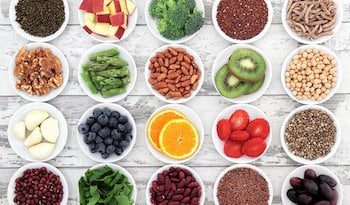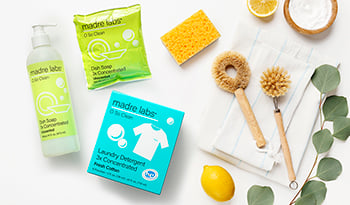Clean Up Your Laundry Routine
DISCLAIMER:This blog does not intend to provide diagnosis...

We all have dirty laundry, but many commercial laundry detergents contain toxic ingredients that could be harmful to health. Making more conscious choices about laundry products could not only lessen toxin exposure for you and your family but also may also have a more positive impact on the environment. Here are our tips on how to make safer choices when it comes to laundry cleaners.
Start with Choosing the Right Detergent
Begin your safer and sustainable laundry journey by choosing a different type of detergent.
When looking for a non-toxic commercial detergent option be sure to read the label carefully. Look for one that has natural, plant-based ingredients and avoid anything that contains dyes, fragrances, and phosphates. The label should indicate that it is safe for septic and gray-water systems as well.
Many local farmers’ markets have a stand for home supplies where you can refill a reusable container with natural homemade laundry detergent. Try to see if there is a local flagship store with this kind of option in your community. Or use ingredients straight from your kitchen to make this recipe for non-GMO laundry detergent from our article on non-GMO cleaners.
Look out for These Toxic Ingredients in Your Laundry Products
Most people enjoy taking their clean clothes from the dryer freshly washed with traditional detergent, softened with traditional fabric softener, and given an extra boost with standard dryer sheets. Would they be as excited if they knew what those products contained and their side effects? Be on the lookout for these harmful ingredients in your products.
Sodium lauryl sulfate and sodium lauryl ether sulfate (SLS/SLES) are surfactants and main ingredients in traditional laundry detergent and other cleaning products. Surfactants, or surface-active agents, are foaming agents that break down the interface between dirt and oils and water so that they're easier to remove. They also potentially cause inflamed skin, eyes, and lungs and could possibly damage internal organs.
Phosphates are another toxic ingredient in laundry detergent. Exposure has been linked to osteoporosis and cardiovascular disease. Formaldehyde, another common ingredient, increases the risk of chronic disease when exposed to it, and the ingredient ammonium sulfate is considered so toxic that manufacturers do not recommend using it indoors.
Eco-Friendly Fabric Softener and Dryer Sheets
Don't stop with detergent. Assess your fabric softener and dryer sheets as well. Traditional fabric softeners are filled with chemicals that coat fabric surfaces with lubrication to make them feel smoother and resist developing static electricity. Some of the chemicals used include alpha terpineol, chloroform, benzyl acetate, ethanol, and linalool.
In addition to changing your detergent, fabric softeners, and dryer sheets consider a few other tips to help make your laundry routine greener:
- Wash in cold water
- Conserve energy by doing only full loads
- Air-dry clothes




